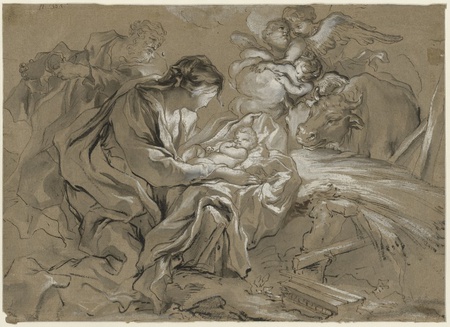![]()
From the sketchbook of Italian history: 53 drawings on loan from the British Museum can be seen in San Diego
Michelangelo’s drawing of “The Three Crosses” is a study of composition and anatomy and a rare look into the artist’s thought process as he worked out ideas. Drawn in red chalk on paper, the illustration is one of a series of studies of the crucifixion Michelangelo worked on 500 years ago.
And it is one of a collection of 53 Italian Renaissance and Baroque works on paper on loan from the British Museum in London that will be on display at the Timken Museum of Art in Balboa Park and the University of San Diego’s Hoehn Family Galleries.
All of the pieces focus on the theme of Christ’s birth, death and resurrection and range from the 1400s to the early 1800s. Some of the works are sketches for paintings, others are commissions or personal drawings. All are small marvels of preservation.
“It is a miracle that something as fragile as a piece of paper has survived. … But at the same time paper is a relatively tough organic material which adapts to changing conditions and they have come down to us in remarkably fresh condition,” Hugo Chapman, the British Museum’s keeper of prints and drawings, said via email. Chapman curated the exhibition with his colleague Sarah Vowles, choosing the pieces from the museum’s collection of 50,000 drawings and more than a million prints.
The Timken will display a dozen drawings and the rest, including Michelangelo’s “The Three Crosses” and some prints, will be at USD’s University Galleries.
The exhibitions started with the idea of bringing in one Michelangelo drawing, said Derrick Cartwright, the director of the University Galleries and the director of curatorial affairs at the Timken. “It would have been memorable just to walk into a gallery and look intently at that one thing,” he said. But the project grew to cover 400 years of art and draftsmanship starting with the beginning of the Renaissance.
Some are extremely rare, such as Benozzo Gozzoli’s “Study of Angels.” It’s the only surviving preliminary drawing for the “Adoration of the Magi” frescoes the Palazzo Medici Riccardi chapel in Florence done in the mid 15th-century. “Graphic works from the 1400s are exceptionally rare, both for drawings and in some cases even for prints, so I am delighted that we have brought such an amazing collection of them to San Diego,” Chapman said.
The early pieces emphasize perspective and balance and “are based on a close observation of the world,” Cartwright said. Changes in artistic practices can be observed over time. By the Baroque period, artists added drama and passion and elements became more twisted and fluid.
“These works are tour de forces of human accomplishment,” Cartwright said.
“We also wanted to make the point that there are fabulous works by artists whose names are not familiar outside specialist circles, such as the late 16th-century painter Camillo Procaccini, who worked in Milan. His red and black chalk study of a shepherd blowing a bagpipe is an extraordinarily precise and beautiful analysis of how light can be used to create a sense of the solidness and roundness of a body,” Chapman said.
“Both exhibitions are studded with works like that which take the breath away,” he said.
And while all the pieces are religious, the drawings should have a broad appeal for their beauty.
“Birth and death are universal themes in human existence, and the joys and sorrows of Mary conveyed in the works are those felt by any mother, or indeed family member, at such moments,” Chapman said. “The power of great art is to make us feel empathy with others, and the works in the show manage to do that time and time again. While the works are orientated around Christ’s life, they can be enjoyed and appreciated with no prior knowledge of the Bible, religious belief or indeed art history.”
The exhibitions tell a number of stories, he said, from the development of graphic arts to regional differences in styles and the imagination employed to tell familiar narratives in new ways. Other stories are more personal, such as the one of Florentine artist Andrea del Sarto.
“I find his black chalk drawing of the Virgin Mary holding the body of her son in her lap with mourning saints that will be on view in the Timken an incredibly moving meditation on death and loss. It is very carefully drawn and precise, and that too is revealing because we know he made it to help out his less-talented brother who was also a painter,” Chapman said. “I find it touching that such a busy artist found time to provide a design to guide his brother, and the drawing is certainly much better than the painting.”
Chapman called the exhibitions a “once in a lifetime” collection. After a stop in Santa Fe, N.M., the pieces will be returning to the vaults of the British Museum.
“Once the works are back in their boxes at the British Museum, they can be studied individually in our Study Room, but the unexpected dialogues that will thrillingly open up when the works hang together for the very first time in San Diego cannot be replicated,” Chapman said.
“Masterpieces of Italian Drawings from The British Museum”
When: Friday through Dec. 15
Where: Timken Museum of Art, 1500 El Prado, Balboa Park
Admission: Free
Phone: (619) 239-5548
Online: timkenmuseum.org
“Christ: Life, Death and Resurrection, Italian Renaissance Drawings & Prints from the British Museum”
When: Sept. 13 through Dec. 13
Where: University Galleries, University of San Diego, 5998 Alcalá Park, San Diego
Admission: Free, reservations recommended
Phone: (619) 260-7516
Online: sandiego.edu/galleries
